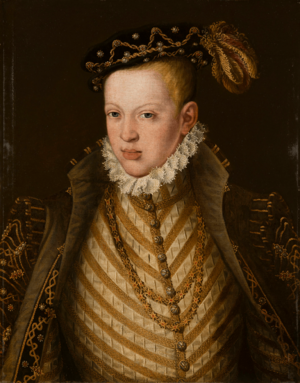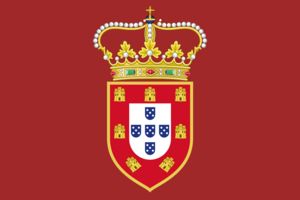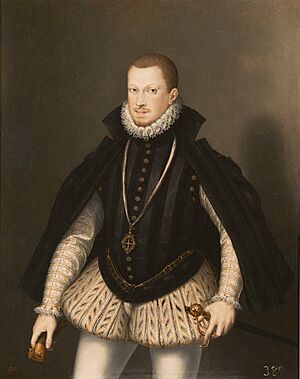Sebastian, King of Portugal facts for kids
Quick facts for kids Sebastian |
|
|---|---|
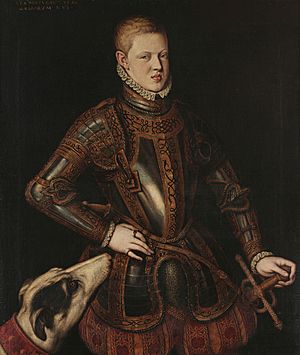
Portrait by Cristóvão de Morais, c. 1571–74
|
|
| King of Portugal | |
| Reign | 11 June 1557 – 4 August 1578 |
| Coronation | 16 June 1557, Lisbon |
| Predecessor | John III |
| Successor | Henry |
| Regents | Catherine of Austria (1557–1562) Henry of Portugal (1562–1568) |
| Born | 20 January 1554 Ribeira Palace, Lisbon, Kingdom of Portugal |
| Disappeared | 4 August 1578 (aged 24) Ksar el-Kebir, Saadi Sultanate |
| House | Aviz |
| Father | João Manuel, Hereditary Prince of Portugal |
| Mother | Joanna of Austria |
| Religion | Roman Catholicism |
| Signature | |
Sebastian I (born 20 January 1554 – died 4 August 1578) was the King of Portugal. He ruled from 11 June 1557 until his disappearance on 4 August 1578. He was the second to last king from the House of Aviz in Portugal.
Sebastian was the son of João Manuel, Prince of Portugal, and Joanna of Austria. His grandparents were King John III of Portugal and Catherine of Austria, Queen of Portugal. He is believed to have died in a big battle in Morocco, called the Battle of Alcácer Quibir. Many people in Portugal hoped he would return. Because of this, he was often called the Desired (o Desejado) or the Hidden (o Encoberto). People believed he would come back on a foggy morning to save Portugal in its greatest time of need. This is like the legend of a "king asleep in a mountain."
Contents
Early Life of King Sebastian
Sebastian was born on 20 January 1554. This was the feast day of Saint Sebastian, so he was named after the saint. This name was not common for royal families in Europe at that time.
Becoming King as a Child
Sebastian was born to be the next king. His father had died two weeks before he was born. Soon after Sebastian's birth, his mother, Joanna of Spain, left him. She went to Spain to rule for her father, Emperor Charles V. Later, she ruled for her brother, Philip II of Spain. Joanna stayed in Spain and never saw her son again. She died in 1573.
Sebastian became king when he was only three years old. This happened after his grandfather, King John III, passed away. Since Sebastian was so young, someone else had to rule for him. This was called a regency. First, his grandmother, Catherine of Austria, Queen of Portugal, was the regent. Then, his great-uncle, Cardinal Henry of Évora, took over. During this time, Portugal continued to expand its empire. They gained more land in Brazil, Angola, Mozambique, and Malacca. They also took over Macau in 1557.
Sebastian was a smart and energetic boy. People who knew him said he was brave and very strong. He was tall, thin, and had blond hair. His grandmother Catherine raised him. She was a strong woman who kept a close watch on him. As a child, he was obedient. But as he grew older, he became stubborn and acted on impulse.
Sebastian's Education
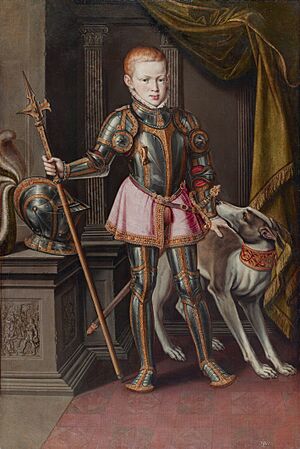
The young king was taught by Jesuits. Aleixo de Meneses, a respected military man, was his main tutor. Other teachers included priests Luís Gonçalves da Câmara and Amador Rebelo.
His education made Sebastian very religious. He always carried a book by Thomas Aquinas with him. Two priests from the Theatine Order were always with him. They wanted to keep the king pure and innocent. When visitors came, Sebastian would often hide with the monks until they left.
Plans for Marriage
Sebastian died young and never got married. However, there were several plans for him to marry. The Queen of France, Catherine de' Medici, wanted him to marry her youngest daughter, Margaret of Valois. Sebastian's uncle, King Philip II of Spain, sometimes supported this idea.
But Sebastian stopped this plan himself. He said he was not happy with how France was treating the Huguenot Protestants. He did not want to marry into the House of Valois until he saw how things would turn out. Later, he agreed to marry Margaret. This was after the Pope's messengers convinced him. He wanted to stop her from marrying the Huguenot Henry of Navarre. But by then, the French king and his mother wanted Margaret to marry Henry. Sebastian's offer was turned down, and Margaret married Henry in 1572.
Sebastian was also offered his cousin Elisabeth of Austria. She was the daughter of Emperor Maximilian II. In 1577, Sebastian himself suggested marrying his first cousin Isabella Clara Eugenia. She was the daughter of his uncle, Philip II of Spain.
Sebastian's Later Reign
When Sebastian became old enough to rule on his own in 1568, he worked to make Portugal stronger. He improved relationships with the Holy Roman Empire, England, and France. He also changed many parts of his kingdom's government, justice system, and military. In 1568, Sebastian created scholarships. These helped students who wanted to study medicine or pharmacy at the University of Coimbra.
That same year, he rewarded native Brazilians who helped fight against the French. The leader of the Temiminós Tribe, Arariboia, received land near the Bay of Guanabara. In 1569, Sebastian asked Duarte Nunes de Leão to gather all the laws of the kingdom. This collection was called the Código Sebastiânico (Sebastian's Code).
During a big plague in Lisbon in 1569, Sebastian brought doctors from Seville. They helped Portuguese doctors fight the disease. He also opened two hospitals in Lisbon for people who were sick.
He cared about the widows and orphans of those who died from the plague. He created special shelters for them. These were called the Recolhimento de Santa Marta and the Recolhimento dos Meninos. He also provided wet nurses to care for the babies.
Legal Changes by Sebastian
Sebastian created new laws for the military, called the Lei das Armas. These laws became a model for how armies were organized. In 1570, Goa was attacked by an alliance of Asian countries. But the Portuguese successfully defended it. Also in 1570, Sebastian ordered that native Brazilians should not be used as slaves. He also ordered that those already held captive should be freed.
In 1572, the famous poet Luís de Camões presented his great work, Os Lusíadas. He dedicated a poem to Sebastian, which earned him a royal payment. In 1573, Sebastian ordered the building of the Royal Basilica in Castro Verde. This was to honor the Battle of Ourique. In 1575, with the Carta de Lei de Almeirim, the king set up a system for measuring goods. He also defined the roles of public servants.
The Celeiros Comuns (Communal Granaries) opened in 1576. Sebastian ordered these to be built. They were places that lent money, seeds, and goods to poor farmers. This helped farmers when their crops were bad. Farmers could pay back their debts with farm products later.
Sebastian also appointed the mathematician Pedro Nunes as a teacher for sea pilots. During Sebastian's rule, Nunes wrote his book Petri Nonii Salaciensis Opera.
In 1577, Sebastian's new law, Da nova ordem do juízo, made legal actions faster. It also set rules for lawyers and court officials. It created fines for delays in court cases.
Sebastian's Final Plans
After Sebastian became an adult king in 1568, he dreamed of a big crusade. This was a religious war against the kingdom of Morocco. Portugal had lost several important trading posts there in the past.
A fight over who would be the next ruler in Morocco gave Sebastian his chance. In 1576, Abu Abdallah Mohammed II Saadi lost his throne and came to Portugal. He asked King Sebastian for help to defeat his uncle and rival, Abu Marwan Abd al-Malik I Saadi. His uncle was supported by the Turks.
In late 1577, Sebastian met with his uncle, King Philip II of Spain, in Guadalupe. Philip refused to join the crusade. He was trying to make peace with the Ottoman Empire. However, he did promise to send some Spanish volunteers.
Even without a son or heir, King Sebastian started his crusade in 1578. The Portuguese army had 17,000 men. This included many soldiers hired from other countries like the Holy Roman Empire, the Netherlands, Spain, and Italy. Almost all of Portugal's noble families joined. They sailed from Lisbon in early June. They stopped in Cádiz, expecting Spanish volunteers who never showed up. Then, they crossed into Morocco.
Disappearance and Probable Death
At Arzila, Sebastian met his ally, Abu Abdullah Mohammed II. Abu Abdullah had about 6,000 Moorish soldiers. Against the advice of his commanders, Sebastian marched his army further inland. At the Battle of Alcácer Quibir (also called the Battle of the Three Kings), the Portuguese army was defeated. Abd Al-Malik led an army of more than 60,000 men.
Sebastian was almost certainly killed in this battle. He was last seen riding bravely into the enemy lines. It is not certain if his body was ever found. However, Philip II of Spain claimed to have received his remains from Morocco. Philip said he buried them in the Jerónimos Monastery in Belém, Lisbon. This happened after Philip became King of Portugal in 1580. But the body could not be confirmed as Sebastian's. This made some people doubt that he was truly dead. Sebastian was followed as king by his great-uncle Henry, who was the brother of his grandfather, King John III.
Sebastian's Legend and Legacy
Over the years, people have had many different ideas about Sebastian. Some were negative, some positive, but rarely did anyone feel neutral about him.
Timothy Coates wrote that Sebastian was "an immature and headstrong youth." He added that Sebastian's strong desire to continue the Christian reconquest into Morocco "led not only to his death but ultimately to the end of the House of Aviz."
On the other hand, Anthony R. Disney, a historian, said that Sebastian was "one of the most extraordinary monarchs that Portugal ever produced." He also noted that Sebastian was "widely acclaimed as the answer to his subjects’ prayers." Disney said Sebastian was "conscientious about the duties of kingship, enacted much legislation and showed considerable compassion for the poor."
People Claiming to Be Sebastian
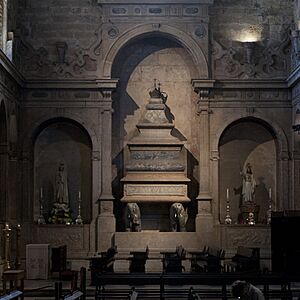
After the defeat at Alcácer Quibir, many efforts were made to free Portuguese soldiers held captive in Morocco. Several soldiers returned to Portugal. This made many Portuguese believe Sebastian had survived the battle and would come back to claim his throne. This led to a belief called Sebastianism. It was the idea that Sebastian could return at any moment. Politically, some people believed that Philip II was not the rightful king. Because of this, several people appeared in Portugal and Spain claiming to be the king. They were imposters. During the time when Spain and Portugal were united (1580-1640), four different people claimed to be King Sebastian. One of them, an Italian, was hanged in 1619. Another was caught by the Spanish, tried, found guilty, and hanged in 1603.
Over a long time, many myths and legends about Sebastian appeared. The main one was that he was a great Portuguese hero. He was seen as the "sleeping king" who would return to help Portugal in its darkest hour. This is similar to legends about King Arthur in Britain or Frederick Barbarossa in Germany.
He became known by special names: O Encoberto (The Shrouded One) who would return on a foggy morning to save Portugal. He was also called O Desejado (The Desired One). These legends became very popular through rhymes written by António Gonçalves de Bandarra. Even in the 1800s, peasants in Brazil believed the king would return to help them in their rebellion.
Sebastian's life was made into an opera in 1843 called Dom Sébastien by Gaetano Donizetti. A Belgian writer, Paul Dresse, also wrote a play about him in 1975. The story of Sebastian's disappearance is also the basis for a popular song by the Portuguese band Quarteto 1111.
Sebastian's Reputation in Morocco
Even though Sebastian was defeated in battle, his reputation in Morocco remained positive for centuries. He was seen as a symbol of great bravery and honor. In 1923, a Portuguese expert named Afonso de Dornellas visited Morocco. He was told by a Moroccan minister that "there were Portuguese here of such breadth that for many leagues in distance they were spoken of with respect and admiration by the Arabs." The minister also said that "for a king to leave his greatness, his life of luxury, of glamour and to embark en masse with his people to fight here for their faith" was a great example. At Asilah, the governor told Dornellas that "this is where Sebastian landed, the great king of the Portuguese and whom we still esteem today as though he was the best of our kings."
See also
 In Spanish: Sebastián I de Portugal para niños
In Spanish: Sebastián I de Portugal para niños
- List of people who disappeared
- Rossio railway station


